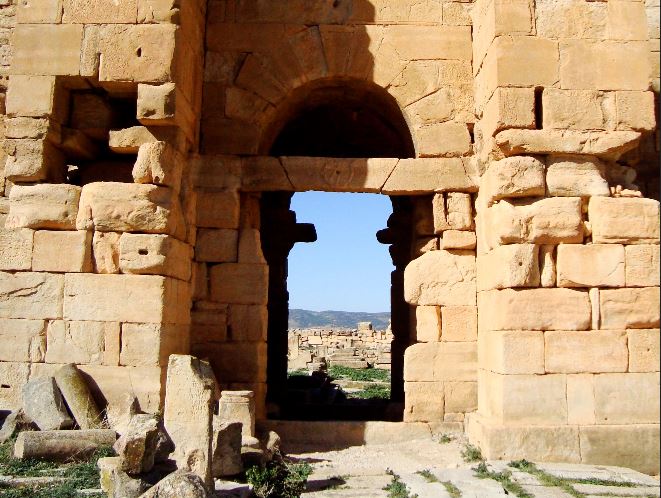Madauros: A Testament to the Vanished Glory of Rome in Algeria
The ruins of the ancient city of Madauros is one of Algeria’s most important archaeological sites and yet it is virtually unknown because of its remote location, which has helped to preserve the city. The Madauros ruins are situated in hilly country and some thirty miles from the Tunisian border near the modern Algerian town of M’daourouch, in Souk Aras Province and is not a tourist site.
The Center of Madauros Is Still Dominated by A Byzantine Ruin
The Madauros ruins are approximately 267 acres in size and it is estimated that only seventeen acres have been fully excavated. The ruins of the Roman city were excavated by French archaeologists between the 1920s and 1940s and since then there has been very little digging at the site. Madauros has many remarkably preserved ruins and when wandering among the ancient stones you can almost feel like you are going back in time to the Roman era.
The original cobbled stone road leading to the ruined town and the city gates can still be made out. The layout of the city was typically Roman, and Madauros has many of the characteristics of other cites from antiquity. The Roman mausoleum at the entrance to the site still has some statues although these are now mostly broken.

Ruins of Madauros (Expert Algeria)
The city’s theater is arguably the most impressive of the remains and the stone seating where Romans and others once sat while they were being entertained by performers is still there. Found at the site are some fine examples of Roman thermae or baths, which were so much a part of urban living in antiquity. It is possible to wander into the thermae whose walls and even stone seats are well-preserved. Then there is a Roman basilica in the heart of the site, which was one of the most important public spaces in the city where the urban elite met and most of the city’s commerce was conducted.
During the Christian period, the basilica was used as a place of worship and its three sections of columns are still intact. In the seventh century, the Byzantines constructed a fortress in the heart of the city using stones and masonry from buildings built in the Roman era and the center of Madauros is still dominated by this Byzantine ruin.

Madauros Ruins (Public Domain)
From the perspective of scholars, the ruined city is important because of the many Latin inscriptions that were found. There are some standing gravestones with epitaphs as well as some inscriptions of Latin poetry in the bath houses, all of which a French scholar has collected and published in a volume.
The Legendary Romano-Berber Warrior Queen, Kahina
It appears that there was a settlement on the site since at least 300 BC. However, the Roman city of Madauros was found in the first century by the Emperor Neva. It was originally a colony and its earliest inhabitants were veterans of the Roman Legions. It was officially known as Colonia Flavia Augusta Veteranorum Madaurensium.
- The Ancient Fairy Tale Of Cupid And Psyche, Where Love Endures Against All Odds
- Saint Augustine Of Hippo And His Detours On The Long And Winding Path To Christianity
- The Royal Mausoleum Of Mauretania: Deadly Wasps Once Prevented Its Destruction
The city prospered in the first centuries of Roman rule and was one of the most important urban centers in the province of Numidia. It appears that it was populated mainly by local Berbers who became Romanized. By the fourth century, Madauros was a Latin speaking Christian city. It appears that after the fall of the Western Roman Empire the city went into decline and it became part of the Vandal Kingdom of North Africa. Later it was conquered by the Byzantines in the sixth century, who fortified Madauros.

Kahina the Warrior Queen (Public Domain)
The city was at some point abandoned before or during the Arab invasions in the seventh century. However, there is speculation that a legendary Romano-Berber Warrior Queen, Kahina who fought the Muslims, ordered the city to be destroyed and abandoned. She was famed for her beauty and many believed that she was a prophetess. Though outnumbered for many years before her defeat and death, she resisted the Arabs heroically.
The Most Famous Son of Madauros
The city was something of a cultural center and it has been claimed that St Augustine, one of the most important Christian theologians, studied in Madauros. It was an episcopal see and became an important Christian center - the city’s bishops played a very important role in the development of the Christian Church in North Africa.
The most famous son of Madauros is Apuleius, who was born and received his early education there. He wrote the celebrated Roman novel, The Golden Ass, which is still studied and read today.

Cupid And Psyche: A Mythological Tale, From The Golden Ass Of Apuleius (Public Domain)
Those who wish to visit the site may have to rent a car or hire a taxi as any other way in is very difficult.
Top image: Madauros Source: Expert Algeria
By Ed Whelan



















